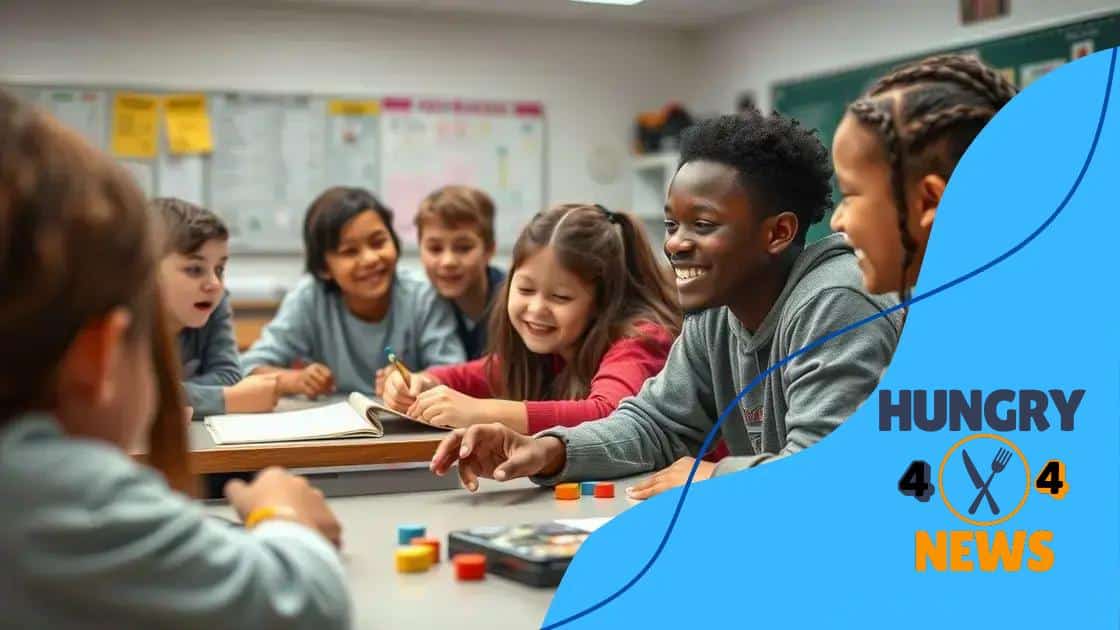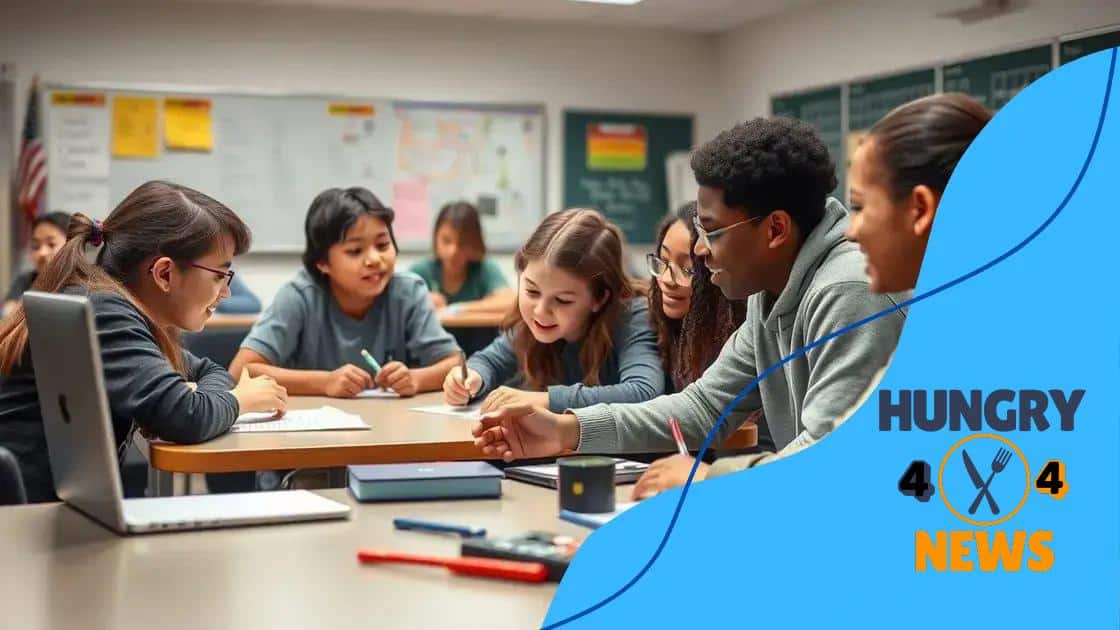Gamification in education to enhance engagement

Gamification in education enhances student engagement by integrating game elements, making learning fun and interactive through techniques like point systems, badges, and collaborative challenges.
Gamification in education is transforming traditional learning environments by integrating game-like elements. Have you ever wondered how adding rewards and competition can motivate students? Let’s dive into the possibilities!
Understanding gamification in education
Understanding gamification in education is essential for modern teaching practices. This approach integrates game design elements into the learning process. By doing this, educators can boost student motivation and enhance learning outcomes.
What is Gamification?
Gamification involves using gaming elements in non-gaming contexts. In education, it includes features like points, badges, and leaderboards. These elements can make learning more enjoyable and engaging.
When teachers apply gamification, they often see better participation from students. Games instill a sense of competition while also encouraging collaboration. Students feel a greater sense of achievement when they complete tasks that are presented in a game-like format.
Benefits of Gamification in Education
- Increased Engagement: Students are more likely to participate when lessons feel like games.
- Enhanced Motivation: Rewards and challenges can drive students to excel.
- Instant Feedback: Gamified systems often provide immediate results, helping students know where they stand.
- Develops Skills: Gamification can promote critical thinking and problem-solving abilities.
As we explore further, it’s important to note that gamification isn’t just about fun. It’s a strategic method to improve learning. Educators should tailor their gamification strategies to fit their students’ unique needs. Personalized learning ensures that each student can benefit, regardless of their skill level.
Implementing gamification can start small. Teachers might begin with simple quizzes that include points or rewards for achievements. As they grow more comfortable, they can add challenges and competitions. The key is to create a balance that fosters a positive learning environment.
Ultimately, understanding gamification in education means recognizing its potential to transform classrooms. By tapping into students’ love for games, educators can create engaging experiences that promote lifelong learning.
Benefits of gamification for student engagement
The benefits of gamification for student engagement are significant and multifaceted. By introducing game elements into the learning process, educators can create a more interactive and enjoyable environment.
Increased Motivation
Gamification boosts student motivation. When learning feels like a game, students are more eager to participate. They strive to earn rewards and achieve higher scores, which encourages them to push their limits.
- Interactive Learning: Games allow students to learn through experience, fostering deeper understanding.
- Goal Setting: Students set personal goals and work towards them, which gives them a sense of ownership.
- Challenge and Reward: The thrill of overcoming challenges leads to greater satisfaction and commitment to their education.
Another advantage is that gamification caters to different learning styles. Some students thrive in competitive settings, while others excel in collaborative environments. Using a variety of game elements can help engage all types of learners, creating a more inclusive classroom.
Enhanced Collaboration
Gamification encourages teamwork and collaboration among students. When placed in competitive or team-based scenarios, students often work together to solve problems and achieve common goals.
These collaborative activities help develop social skills and promote communication. As they engage with their peers, students learn how to share ideas effectively and offer constructive feedback. Such interactions enhance their overall learning experience and build a sense of community within the classroom.
Moreover, the immediate feedback provided by gamified systems keeps students informed about their progress. This feedback helps them identify areas for improvement and motivates them to continue striving for excellence.
By focusing on the benefits of gamification for student engagement, educators can harness the power of game-based learning to create an exciting educational atmosphere. This approach not only increases student involvement but also builds essential skills that will serve them well in their academic journey.
Strategies for implementing gamification in classrooms

Implementing gamification in classrooms requires thoughtful strategies that foster an engaging learning environment. It’s not just about adding points or badges; it’s about creating meaningful experiences for students.
Set Clear Learning Goals
Before incorporating gamification, educators need to define clear learning objectives. Knowing what students should achieve allows teachers to design game elements that directly support these goals.
- Identify Key Topics: Focus on the most important concepts that students need to learn.
- Align Activities: Ensure that gamified activities are aligned with curriculum standards.
- Develop Milestones: Create checkpoints to measure progress along the way.
Students are more engaged when they understand what they are working towards. This clarity can drive their motivation and commitment to the material.
Incorporate Game Mechanics
Using game mechanics effectively can enhance the classroom experience. Mechanics like point systems, levels, and leaderboards motivate students to participate actively. For example, awarding points for completing assignments or participating in discussions can spark competition among peers.
Offering different levels can cater to varied skill sets. Students can choose tasks based on their comfort level, which helps them feel challenged without overwhelming them. Adding leaderboards can cultivate a fun competitive spirit while encouraging improvement.
Creating scenarios or challenges can be very effective as well. By framing lessons within an engaging narrative, teachers can capture students’ imaginations and make learning more relatable. This not only aids retention but also fosters a sense of belonging.
Feedback plays a crucial role in gamification. Regular, immediate feedback keeps students informed about their progress. This guidance is essential for encouraging growth and persistence.
Encourage Collaboration
Gamification isn’t just about individual success; it can also promote teamwork. Incorporating group challenges encourages students to work together, share ideas, and develop social skills.
By assigning tasks that require collaboration, educators can help students build a sense of community. This can lead to deeper engagement and satisfaction as students learn from each other.
Ultimately, effective strategies for implementing gamification in classrooms can lead to a more dynamic learning environment. As teachers thoughtfully apply these techniques, they can inspire their students to learn and grow in exciting new ways.
Examples of successful gamification in education
Exploring examples of successful gamification in education reveals how innovative strategies can transform classrooms. Many educators have adopted game elements to enhance learning experiences, and their success stories are inspiring.
Classroom Challenges
One effective example is the use of classroom challenges. Teachers create competitive scenarios where students form teams to solve problems or complete tasks. This approach fosters collaboration, critical thinking, and healthy competition.
- Math Challenges: Students race to solve math problems, earning points for accuracy and speed.
- Spelling Bees: Using gamified spelling competitions encourages students to improve their vocabulary.
- Science Experiments: Teams can compete to design the best science project, showcasing creativity and knowledge.
These challenges not only make learning more engaging but also help students develop essential skills in a fun way.
Digital Badges and Recognition
Another example of successful gamification is the use of digital badges. Schools and teachers reward students with badges for completing tasks, mastering skills, or exhibiting positive behavior. Badges serve as visual symbols of achievement and motivate students to reach their goals.
Many platforms now allow educators to create custom badges for their classrooms. This enables them to recognize students for individual accomplishments, reinforcing their efforts. The sense of achievement associated with earning badges is powerful and encourages continuous learning.
Interactive Learning Platforms
Interactive learning platforms like Kahoot! and Quizizz provide gamified quizzes and learning activities. These tools allow teachers to create engaging quizzes where students can compete against one another in real time. The instant feedback and competitive nature of these platforms keep students excited and motivated.
Using these platforms can lead to improved retention of information. The interactive element engages students and allows them to learn through play, making concepts easier to grasp.
By examining these examples of successful gamification in education, it becomes clear how gamification can enhance student engagement and learning outcomes. Integrating game-like elements into the classroom creates a more dynamic and interactive educational experience, helping students develop crucial skills in an enjoyable way.
Evaluating the effectiveness of gamification programs
Evaluating the effectiveness of gamification programs is crucial for understanding their impact on student engagement and learning. To measure success, educators need clear methods and metrics.
Setting Clear Objectives
First, it’s important to set clear educational objectives before launching any gamification program. Knowing what you want to achieve helps in evaluating the program’s outcomes. Whether it’s to improve test scores, increase participation, or enhance skill retention, these goals provide a benchmark for success.
- Define Metrics: Establish which metrics will gauge success, such as grades, participation rates, and retention of information.
- Use Surveys: Collect feedback from students about their experiences and perceptions of the gamified elements.
- Monitor Progress: Track student progress regularly to see how gamified elements influence learning.
Using these methods, educators can gain valuable insights into how gamification affects their students.
Data Collection Techniques
Once objectives are set, it’s time to implement data collection techniques. This involves gathering both qualitative and quantitative data to assess the program’s effectiveness. Qualitative data include student feedback and teacher observations, while quantitative data consist of test scores and attendance records.
Analyzing this data can reveal trends and patterns. For example, increased participation in classes with gamified components could correlate with improved academic performance. By examining various data sources, teachers can get a well-rounded view of the program’s impact.
Another useful method is comparing groups of students who participate in gamified learning with those who experience traditional teaching methods. This allows for a clearer understanding of the benefits associated with gaming elements in education.
Continuous Improvement
Finally, using evaluation results facilitates continuous improvement of gamification programs. Educators can identify what works and what doesn’t. Regularly updating the gamified elements based on student feedback ensures that the programs remain engaging and effective.
Incorporating lessons learned from evaluations helps refine the approach and enhances overall effectiveness. Therefore, evaluating the effectiveness of gamification programs is not a one-time task, but an ongoing process that benefits students in the long run.
In conclusion, gamification in education offers numerous benefits that can enhance student engagement and learning outcomes. By implementing effective strategies, such as setting clear objectives, using engaging game mechanics, and continuously evaluating programs, educators can create dynamic and stimulating learning environments. As more schools adopt gamified elements, the impact on teaching and learning will continue to grow. Embracing these innovative approaches not only makes learning fun but also prepares students for a successful future.
FAQ – Frequently Asked Questions about Gamification in Education
How can gamification improve student engagement?
Gamification makes learning enjoyable by incorporating game elements, which motivates students to participate actively and stay focused.
What are some examples of gamified activities?
Examples include using point systems, digital badges for achievements, classroom challenges, and interactive quizzes to engage students.
How do I evaluate the effectiveness of gamification in my classroom?
You can evaluate effectiveness by setting clear objectives, collecting feedback, monitoring progress, and comparing data from gamified versus traditional methods.
Can gamification benefit different types of learners?
Yes! Gamification caters to various learning styles by providing competitive and collaborative opportunities, making learning accessible and fun for everyone.





